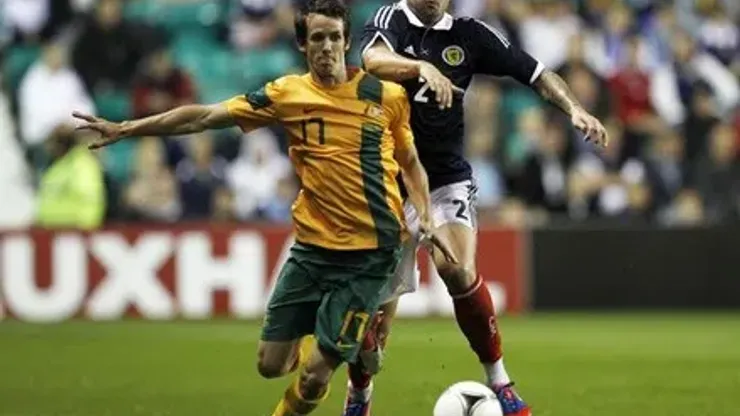On a cold winter’s day in the city of Düsseldorf, as patrons of the city sat in the Esprit Arena watching their side go up against former Bundesliga champions VFB Stuttgart, the Fortuna faithful looked on worried, as their side may be staring at a fifth successive game without a win.
The Flingeraner were flirting dangerously close to the relegation places, as the game was drawing to its end. A stalemate looked to be the result. However, a quick brace from their Australian dynamo Robbie Kruse grabbed them all three points late on.
It would be a sign of things to come, and greener pastures that awaited Kruse. But he’s not alone in being a former A-League footballer who has made strides in the German game.
Since the inaugural Hyundai A-League season, there have been more than eight A-League players that have moved to either the Bundesliga or Bundesliga second division. It’s a sign of the A-League talent being recognized in Germany, as the A-League’s only been in existence for eight years. On average, one player has moved from the A-League to pastures new in Germany each year.
Is this a trend or is just a coincidence? Has Germany become a hotbed for A-League talent, akin to what the UK was for players from National Soccer League (NSL, Australia’s initially national league) in the mid-90s to early 00s?
While links to German sides have been apparent since the lofty days of Ned Zelic, Paul Agostino, Frank Juric and others, the mid-90s and early 00s saw many Australian based players venture to British shores such as Mark Viduka, Craig Moore, Harry Kewell and Tim Cahill. And with the success of the A-League, moving abroad has been highlighted evermore by the Australian football media. Germany in particular has seemed to be a ‘smart move’.
Speaking of smart moves, Robbie Kruse’s transfer to Fortuna Dusseldorf when the club were in the Bundesliga second division is one glowing example. In the beginning he was on the outer fringes of the team, but he has seen his development improve during the last Bundesliga campaign, where he moved to Champions League bound Bayer Leverkusen.
German sides have shown patience and belief in Australian based talent in modern times. A key difference in the structures in most German clubs is a Sporting Director. Therefore, unlike a British all-conquering manager approach, transfers and player recruitment is largely dealt with by directors of football.
In that case, it’s similar to Eli Babalj’s move to Red Star Belgrade where he is realizing he wasn’t wanted after the sacking of the coach who initially signed him. Luckily the Serbian club didn’t finish off the payments to previous club Melbourne Heart, and soon enough he returned to the A-League. Babalj is not alone in this respect. Former teammate and Melbourne Heart defender Michael Marrone had a similar hand dealt to him. When former Italy Coach Roberto Donadoni was sacked, any move to the Serie A was given a crushing blow after an agreement with Cagliari was rejected — a practice Mustapha Amini knows nothing of, after being scouted and signed by Borussia Dortmund. He was loaned back to A-league side Central Coast Mariners to further his development.
Eighteen months on, he’s assimilated slowly into the club and its culture, even making the bench for Dortmund’s Champions League clash against Manchester City earlier in the season where he showed his experience.
Situations like Amini’s don’t happen often, thus making moves for young A-League players vital. Even though the trip to Germany has proven well for some A-League players, it has stunted the growth of others — to an extent leaving them stuck at a glass ceiling they cannot break through — for example, instances like Dario Vidosic’s return to the A-League where he was instrumental in Adelaide’s season, but because of past failings abroad he may not possess the same gravitas, as Marcos Rojas, who recently signed for VFB Stuttgart.
However, players like Michael Beauchamp whose move to the Bundesliga opened doors for future Champions League appearances and a good European career. Beauchamp exemplifies how an A-League footballer can reach the highest levels of professional football, and has not necessarily been the second coming.
The latest A-League talents to venture to German shores are Marcos Rojas and Ben Halloran. The former, as mentioned earlier, agreed a move to VFB Stuttgart, whereas the latter is said to have agreed a move with a 2.Bundesliga side. Fortuna Düsseldorf’s been confirmed as the side who’s taken on the erratic Queenslander. A club that’s already served one former A-League player well, and he’s a Queenslander too. Rojas was named the Johnny Warren Medallist and had a breakthrough season, unlike Halloran who struggled for form and was largely a substitute in Brisbane’s late season surge up the table.
These two are the latest graduates from the A-League school of soccer. Will they enjoy the same joy as others? Only time will tell.
Ahmed is the editor of Australian Football blog Oz Football Weekly. You can follow him on Twitter: @ahmedyussuf10.
200+ Channels With Sports & News
- Starting price: $33/mo. for fubo Latino Package
- Watch Premier League, Women’s World Cup, Euro 2024 & Gold Cup
The New Home of MLS
- Price: $14.99/mo. for MLS Season Pass
- Watch every MLS game including playoffs & Leagues Cup
Many Sports & ESPN Originals
- Price: $10.99/mo. (or get ESPN+, Hulu & Disney+ for $14.99/mo.)
- Features Bundesliga, LaLiga, Championship, & FA Cup
2,000+ soccer games per year
- Price: $5.99/mo
- Features Champions League, Serie A, Europa League & Brasileirāo
175 Premier League Games & PL TV
- Starting price: $5.99/mo. for Peacock Premium
- Watch 175 exclusive EPL games per season






